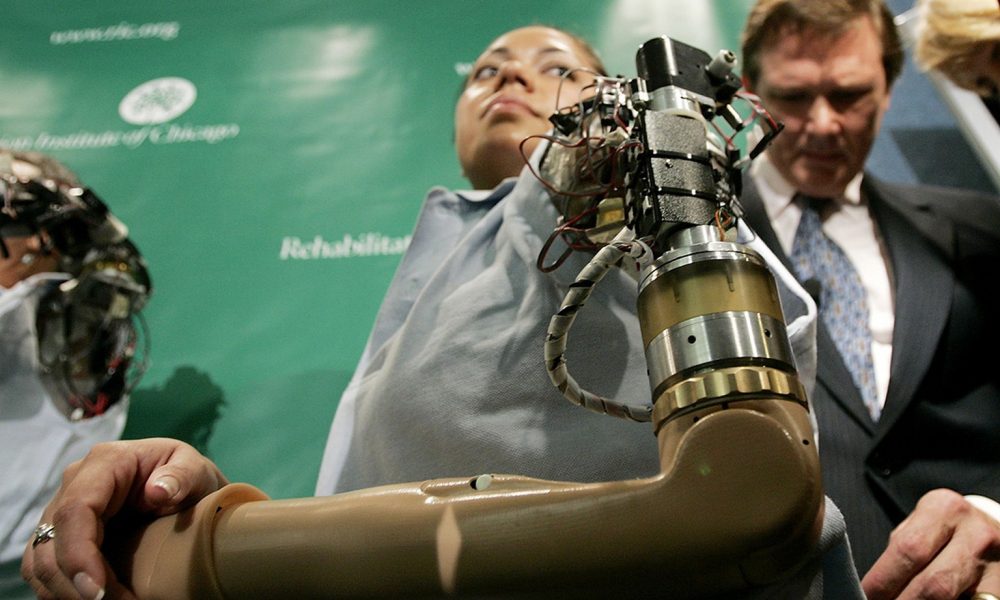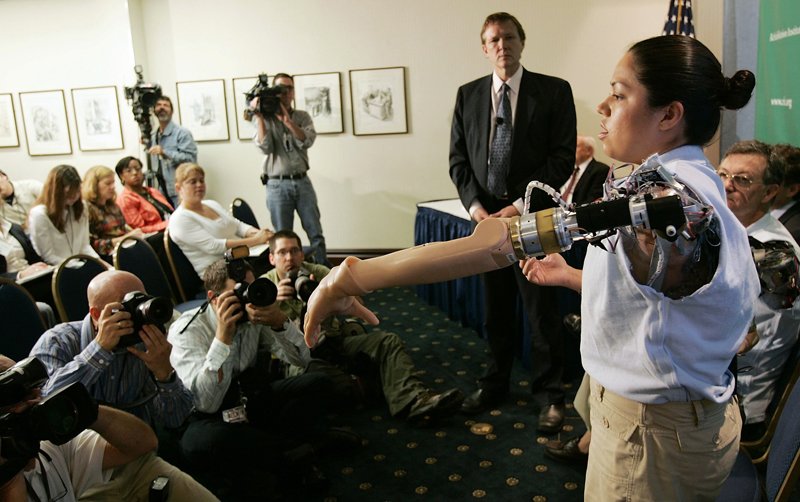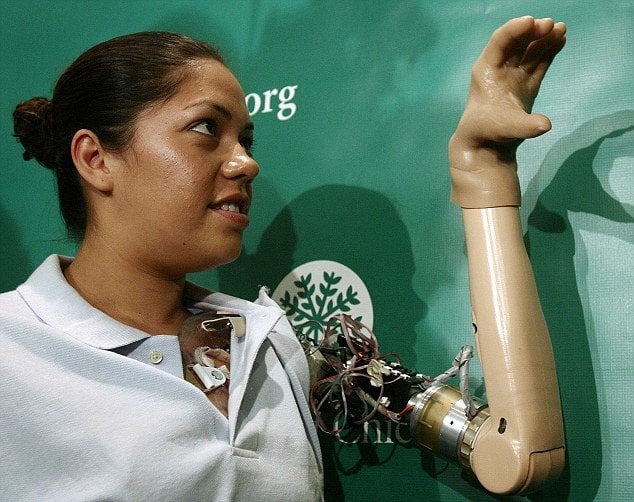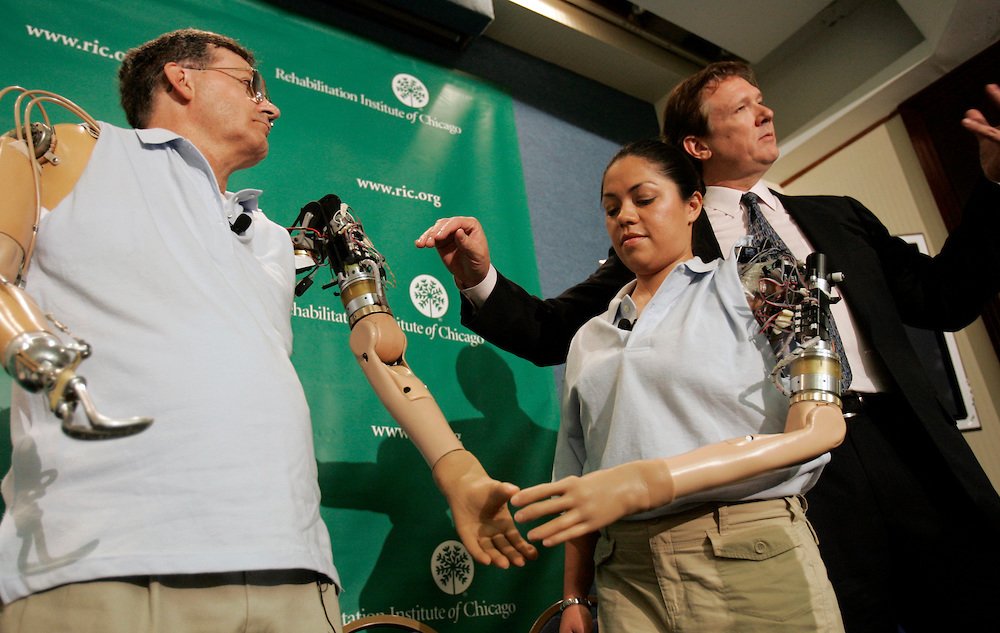
Latest Technology Enables a Marine Veteran Feel With Her Fingers!

Claudia Mitchell, 37, lost her left arm at the shoulder in a motorcycle accident back in 2004. Two years later, the ex-Marine was fitted with a bionic prosthetic and became the first woman to have ever done so. After 12 years, she has now been fitted with an upgraded bionic prosthetic which allows her to feel things using her fake fingers; something that she thought she would never again be able to do.

Claudia Mitchell, who was a former US Marine, also suffered a burst spleen because of the accident
Now, because of this groundbreaking new technology, she is able to do things that a lot of people take for granted, like open water bottles or pick up items with her left hand. Over a decade of research and clinical trials went into the development of this advancement. This cutting-edge technology is only a piece of the research field into prosthetics that is growing in popularity and may change how amputees move their man-made limbs.
The inner workings
According to Cleveland Clinic, Claudia’s new arm is an upgraded version of her prosthetic that was fitted on her in 2006. This arm has a computerized robotic touch system, which lets her regain her lost sense of touch the same way she did with her real left hand. This arm allows her to feel what she is touching, and exactly how hard she needs to grip for it not to fall. Claudia says that she feels when something starts slipping away from her fingers, or if she is squeezing a person’s hand too hard, when before she could only guess by looking.
The arm was developed by a team of researchers at the Cleveland Clinic and Advanced Arm Dynamics, and they also specifically customized it for Claudia’s use. The arm has a harness that has small electrical amplifiers that are connected to the nerves in her chest that were surgically taken from her actual amputation site.
Because of this unique design, whenever Claudia thinks about moving her hand, her chest muscles start to twitch which in turn generate electrical signals that allow the hand and arm to move. Small sensors in the fingers also report information to her chest nerves, which also signals the brain on what her fingers are feeling.
Becoming one with science
Lead researcher Paul Marasco even went as far as saying that Claudia’s prosthetic arm is no longer just a tool that she wears in her daily life. It has actually become a part of her body, just like her remaining flesh and blood arm is. The touch sensation allows the user to actually interact with people and objects more naturally.

Claudia does not let her being fitted with a prosthetic stop her from enjoying the sea.
Claudia has even had the arm decorated, with a blue pattern on top in order to remind her of the ocean. It comes as no surprise due to her status as a former US Marine, but she is also an avid diver and has taken to calling her prosthetic “2Ocean’’ because like the real ocean, the arm makes her feel free and whole again, she disclosed to Cleveland Clinic. She has bonded well with the arm, and she even keeps the nails on the hand manicured because she finds it important for the prosthetic to be as close as possible to what she had before.
Only the beginning

Claudia talks about how her prosthetic arm works and how her daily life has changed
Claudia is actually only one of many amputees who works with Cleveland Clinic in testing bionic prosthetics. The program has been granted over $3 million by the Defense Advanced Research Projects Agency, the US Department of Defense, and the National Institutes of Health. Marasco says that they are learning more and more about how the brain works in processing movement and that they hope to integrate that into their technology to improve the quality of life for people like Claudia who have lost a limb.
Not only with the loss of the limb itself, Marasco’s team also hopes to use what they learn in technology to help people with loss of sensations due to other ailments like diabetes, stroke, and spinal cord injury.
More in Career
-
Why American Consumers Are Falling Behind on COVID-Era Debt
When the world was grappling with the health crisis brought on by COVID-19, the U.S. economy faced an equally formidable challenge:...
November 27, 2023 -
Dr Dre and Ex-Wife Nicole Young Finalise $100m Divorce Settlement
After months of legal proceedings, Dr Dre, the legendary rapper, producer, and businessman, officially brought his tumultuous divorce from ex-wife Nicole...
November 22, 2023 -
5 Tell-Tale Signs That It Is Time to Say Goodbye to Your Current Job
Are you feeling like your job is more like a ball and chain than a fulfilling career? The daily grind, the...
November 19, 2023 -
WWE Signs $1.4 Billion Broadcasting Contract for SmackDown
In an explosive turn of events, World Wrestling Entertainment (WWE) has just unleashed some earth-shattering news for its legions of fans....
November 9, 2023 -
Navigating the Mortgage Maze as Interest Rates Take a Historic Leap
The U.S. housing market is nothing short of a dynamic entity. It evolves, reacts, and sometimes, just like the current real-estate...
November 3, 2023 -
Celebrity Couples Where the Woman Has a Higher Net Worth
In a world where gender roles and financial dynamics constantly shift, it’s not unusual to find celebrity couples where the woman...
October 27, 2023 -
Why the Gender Pay Gap Could Be Worsening
Picture this: Two college students, Alex and Charlie. Both are bright, have the same interests, and are ready to embrace the...
October 19, 2023 -
JC Penney’s Remarkable $1 Billion Revival Plan
In a remarkable turnaround, JC Penney unveiled a bold $1 billion revival plan, breathing new life into a brand that faced...
October 12, 2023 -
Shattering the American Dream: Mortgage Rates, Inflation & Cost of Living
You know that feeling when you are dreaming of something you have wanted for so long, only to watch it vanish...
October 6, 2023















You must be logged in to post a comment Login